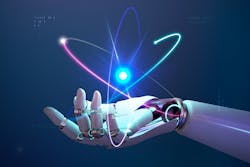Need More Proof Microreactors May Create Microgrid Jobs? Microsoft seeks Nuclear Expert for AI Data Centers
Artificial intelligence is bold, demanding, and more than a little scary, but it’s momentum seems inevitable and may justify the use of an equally powerful energy resource to match its expansion.
The skies the limit for artificial intelligence (AI) in the future information landscape, Microsoft clearly believes as a technology company, and it might require something as energy-dense and high-capacity as nuclear powered microgrids to fuel its flight into the data unknown.
The proof of Microsoft’s commitment to both AI and advanced nuclear is revealed in a job posting. Posted on LinkedIn, one of the nation’s largest companies announced it is seeking an energy industry veteran who can fulfil the newly created role as principal program manager, nuclear technology, according to the job listing.
Microsoft leads the post by noting the exponentially expansive and demanding load required by AI as the predictive and responsive technology likely transforms the commercial, industrial, and information sectors forevermore.
“This senior position,” the company writes, “is tasked with leading the technical assessment for the integration of SMRs (small modular reactors) and microreactors to power the data centers the Microsoft Cloud and AI reside on.”
The new hire will be responsible for maturing and implementing the company’s global SMR and microreactor energy strategy.
“They will maintain a clear and adaptable roadmap for the technology’s integration, diligently select and manage technology partners and solutions, and constantly evaluate the business implications of progress and implementation,” the listing reads.
Microsoft co-founder Bill Gates has long been a supporter of nuclear energy, which is baseload capable and carbon-free. Gates, who has not been involved in day-to-day leadership at the company for many years, nonetheless has helped fund new advanced reactor startups and advocated for the role of future nuclear energy in reaching net zero emissions goals by 2050 and beyond.
Gates’ successor as Microsoft Chairman and CEO, Satya Nadella, is also vocal about how AI will change the technological world in many demanding ways.
“The next major wave of computing is being born, as the Microsoft Cloud turns the world’s most advanced AI models into a new computing platform,” he is quoted as saying at the top of the LinkedIn job listing for the principal program manager for future nuclear technology. “We are committed to helping our customers use our platforms and tools to do more with less today and innovate for the future in the new era of AI.”
The expansion of data centers and resulting energy demand has grown more than five-fold in recent years and likely will add at least that much more load on the grid through the 2030s. A recent report by the International Energy Agency estimated that annual energy capacity for hyperscale data centers went from 10 terawatt hours per year (TWh) in 2010 to nearly 100 TWh last year, while non-hyperscale cloud data centers grew from 18 TWh annually to about 69 TWh within the same time frame.
Microsoft apparently is ready to start communicating and working with vendors on the SMR and microreactor development side of the equation. AI engines, like cryptocurrencies, are astronomical users of energy compared to normal consumptions. According to the internet coverage website iMore, an AI engine like Microsoft’s ChatGPT can use more energy in a single training run than 120 households consume in a year.
OpenAI CEO Sam Altman is also a big proponent of expanding carbon-free energy resources to support the future energy demands of the data revolution. Altman’s group acquired nuclear technology startup Oklo, which was recently selected by the U.S. Air Force to work on developing its microreactor technology for a remote base in Alaska.
While conventional nuclear energy currently supplies power for about 20 percent of the U.S. electricity generation mix and more than half of the nation’s carbon-free power, its function is always met with opposition from those concerned about health and safety issues.
Upcoming SMR and microreactor designs, such as those under way by NuScale Power, X-energy, and others, focus on the smaller geographical and financial footprints of planned nuclear projects. Other works focus on using molten salt or other safety measures to prevent meltdowns and other nuclear plant dangers since the accidents at Fukushima and Chernobyl.
Currently, all commercial nuclear energy is created by fission, bombarding uranium atoms to create reactions that release tremendous amounts of energy in relatively small areas. Some national labs in the U.S. and partners globally are experimenting with nuclear fusion, although that work is still in its infancy stages and most likely decades from commercialization.
The Idaho National Lab and Xendee are among some researching the potential for nuclear microgrids to support data centers, remote military bases, and industrial manufacturing functions in the future.
About the Author
Rod Walton, EnergyTech Managing Editor
Managing Editor
For EnergyTech editorial inquiries, please contact Managing Editor Rod Walton at [email protected].
Rod Walton has spent 17 years covering the energy industry as a newspaper and trade journalist. He formerly was energy writer and business editor at the Tulsa World. Later, he spent six years covering the electricity power sector for Pennwell and Clarion Events. He joined Endeavor and EnergyTech in November 2021.
Walton earned his Bachelors degree in journalism from the University of Oklahoma. His career stops include the Moore American, Bartlesville Examiner-Enterprise, Wagoner Tribune and Tulsa World.
EnergyTech is focused on the mission critical and large-scale energy users and their sustainability and resiliency goals. These include the commercial and industrial sectors, as well as the military, universities, data centers and microgrids. The C&I sectors together account for close to 30 percent of greenhouse gas emissions in the U.S.
He was named Managing Editor for Microgrid Knowledge and EnergyTech starting July 1, 2023
Many large-scale energy users such as Fortune 500 companies, and mission-critical users such as military bases, universities, healthcare facilities, public safety and data centers, shifting their energy priorities to reach net-zero carbon goals within the coming decades. These include plans for renewable energy power purchase agreements, but also on-site resiliency projects such as microgrids, combined heat and power, rooftop solar, energy storage, digitalization and building efficiency upgrades.

